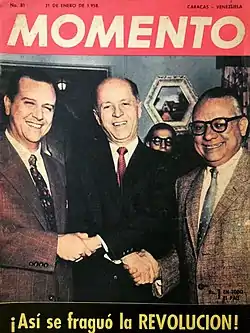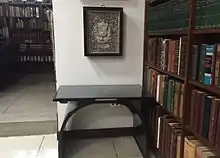Puntofijo Pact
The Puntofijo Pact was a 1958 formal arrangement between three of Venezuela's major political parties - Acción Democrática (AD), COPEI (Social Christian Party), and Unión Republicana Democrática (URD) - to accept the results of the upcoming presidential election and preserve the new democratic system. The Pact was a written guarantee that the signing parties would respect future election results, prevent single-party hegemony, cooperate to fight dictators, share political power, and divide oil wealth amongst themselves.[1]
 1958 magazine cover featuring the leading signatories of the Pact from left to right: Rafael Caldera, Jóvito Villalba, and Rómulo Betancourt. | |
| Signed | 31 October 1958 |
|---|---|
| Location | Puntofijo Residence, Francisco Solano López Avenue, Sabana Grande, Caracas, Venezuela |
| Signatories |
|
| Parties | |
The Pact is credited with undergirding democracy in Venezuela, and inaugurating the most stable period in the history of Venezuela's republics, known as the Puntofijismo.[2][3] While the Pact provided a strong foundation for future democratic development, it was increasingly criticized for starting a corrupt duopoly by AD and COPEI, and it ultimately collapsed by the 1998 Venezuelan presidential election of Hugo Chávez.[4]
Background
On January 23, 1958, President of Venezuela and de facto dictator Marcos Pérez Jiménez fled Venezuela for the Dominican Republic following a popular uprising against him, and a group of military leaders formed a transition government.[5] The regime of Pérez Jiménez had relied heavily on oil revenues to pay for a massive urbanization and modernization campaign in the cities of Venezuela,[5] and the United States had supported the government of Venezuela because it was a reliable oil source.
Following Pérez Jiménez's ouster, three of the four major parties in the country — COPEI, AD, and URD — came together to ensure a lasting democracy in Venezuela, which had not had stable democracy for all of its history since gaining independence in 1830. Notably, the PCV (Communist Party of Venezuela) was not included in this collaboration, nor were the political actors who had been aligned with the Pérez Jiménez regime.
The parties were aware that if one of them disputed the results of the upcoming election, it would seriously damage the country's fledgling democracy, given the economic instability and volatility that had resulted from declining oil prices and the post-coup atmosphere. Even in the few months since Pérez Jiménez's ouster, multiple coup attempts were made against the transitional government. The Pact was a solution for the parties to ensure cooperation and compliance with election results, allowing for a peaceful transition to democracy.
Signing and results

The Pact was signed in, and named after, the residence of COPEI leader Rafael Caldera in Caracas, by representatives for the three parties. Its adherents claimed the Pact was aimed at preserving Venezuelan democracy by respecting elections, having the winners of the elections consider including members of the signing parties and others in positions of power in bids for national unity governments, and having a basic shared program of government.[1] They guaranteed, for example, the continuation of obligatory military service, improved salaries, housing, and equipment for the military, and, perhaps most importantly, amnesty from prosecution for crimes committed during the Pérez Jiménez dictatorship.
The exclusion of the PCV (Communist Party of Venezuela) was significant, given the role the PCV had played as one of the principal opposition parties to Pérez Jiménez. Among the reasons suggested by historians for the exclusion were Cold War dynamics, the rejection of the PCV by the Catholic Church and COPEI, and its close connections to the Communist Party of the Soviet Union.[6]
Three members of each party signed the Pact. These delegations were led by Rómulo Betancourt of AD, Rafael Caldera of COPEI, and Jóvito Villalba of URD, all the original founders and then-leaders of their respective parties.[7] Betancourt, Caldera, and AD signatory Raúl Leoni would all go on to become President of Venezuela. In the short-term, the Pact served to immediately deepen democracy in the region as it successfully ensured an uncontested democratic election of Betancourt later that year.
In the long-term, however, the Pact bound the parties to limit Venezuela's political system to an exclusive competition between the signing parties, limiting the democratic improvement over the Pérez Jiménez regime that could have happened.[8] The agreed rules of the Pact ensured that no matter which party won the Presidency, the others would share in power. The result was permanent coalition-style government that effectively centered power in the hands of COPEI and AD (URD leaving the Pact in 1962).[9] Moreover, it led to future democratic erosion as COPEI and AD became increasingly corrupt, relying on oil revenues to bribe political opponents and assure their dominance over Venezuelan politics.[10] This system would disparagingly be called "partyarchy" by critics who were even less friendly to democracy, among them Hugo Chávez.
Opposition
Initially, the main opposition to the Puntofijo Pact came from journalists and leftists, who objected to the Pact's exclusion of the Communist Party of Venezuela (PCV).[11] They viewed the exclusion as denial of any leftist participation or the more radical reforms they had hoped for when Pérez Jiménez was ousted. In 1962, URD left the Pact in protest of the Betancourt administration's attempts to punish Cuba through the Organization of American States for its support of two guerilla uprisings that year (El Carupanazo and El Porteñazo).[12] Additionally, some of the contributors to Pérez Jiménez's ouster preferred a continued military government, given the memory of instability from the last time democracy had been the style of Venezuelan government.
Later, opposition to the Pact widened to more sectors of society. Criticism focused on the Pact's power-sharing agreement between the two main political parties (COPEI and AD). Citizens, intellectuals, journalists, and the media demanded reform of the entire political system to fit Venezuela's growing democratic society. More open opposition to the Pact emerged in the late 1980s. One of the first indicators of serious public discontent was the 1989 Caracazo, deadly riots in the capital city of Caracas due to government increases in prices of public transportation and gas.[13] The 1993 presidential election brought a decisive and surprising break from the Pact: the founder of COPEI and signatory of the Pact, Rafael Caldera, was elected President for a second term under a new party, Convergencia.[13]
Deterioration
The system of patronage and duopoly of power constructed by the Puntofijo Pact deteriorated in the 1980s when oil revenues, a key component of the Pact's success, took a sharp decline.[4] This was important to the Pact's downfall due to the nature of the 1961 Constitution of Venezuela. The Constitution had originally been designed by AD and COPEI, and was crafted in order to maximize the political benefits of the Puntofijo Pact.[9] The resulting constitutional design gave the Presidency highly concentrated powers. According to Julia Buxton, the Constitution of 1961 gave the Presidency control over "the nation's defense, the monetary system, all tax and tariff policy, the exploitation of subsoil rights, the management of foreign affairs, and a variety of other powers. It had the authority to name all cabinet ministers, state governors, and state enterprise officials."[10] Since the Pact gave AD and COPEI exclusive access to oil revenues, which were used to buy out potential political opponents, the Presidency (and thus many powers of the Venezuelan government) would always be won by AD and COPEI nominees. The exclusiveness of the Pact was most obvious in the exclusion of the Communist Party of Venezuela (PCV) from the Pact itself.
This status quo was interrupted when oil revenues sharply declined in the 1980s. Without the ability to buy out political rivals, the AD-COPEI duopoly began using violence to maintain its dominance, initiating a pattern of escalating violence with the populace. Among this violence was the 1989 Caracazo, where government agents engaged in extrajudicial killings and "disappearances" of citizens. Events reached a fever pitch with the 1992 coup attempts, where Hugo Chávez unsuccessfully attempted to forcefully overthrow the democratic government, then led by President and AD member Carlos Andrés Pérez.
Under Chávez
The Pact of Puntofijo was ultimately invalidated forty years after its creation as Hugo Chávez sought the presidency. The Pact was already irreversibly damaged by the earlier 1993 election of Rafael Caldera under a third party, but the 1998 Venezuelan presidential election effectively ended it. Chávez promised in his presidential campaign that he would eliminate the old system and open up political power to independents and third parties.[14] He ran on a platform of condemning the acts of AD and COPEI, and their duopoly of power, known as "partyarchy," considering the Pact to be "synonymous with elitist rule".[13] As he argued, the Pact of Puntofijo had institutionalized a system of patronage that allowed AD and COPEI to embed themselves in the political system of Venezuela, sustained a government that no longer reflected its citizens, and prevented democratic political participation. Increasing public distrust of the political parties led to a referendum prohibiting parties from participating in the 1999 presidential election entirely.[15] This inherently strengthened Chávez’s anti-establishment rise to power. Citizens themselves offered overwhelming support for the break from the Puntofijismo, handing Chávez the election victory over Henrique Salas Römer, an establishment-backed opponent, by a 16-point margin.
See also
References
- Corrales, Javier (2001-01-01). "Strong Societies, Weak Parties: Regime Change in Cuba and Venezuela in the 1950s and Today". Latin American Politics and Society. 43 (2): 81–113. doi:10.2307/3176972. JSTOR 3176972.
- Rey, J. C. (1991). La Democracia Venezolana y la crisis del sistema populista de conciliacion. pp. 533–578.
- Philip, G. (2003). Democracy in Latin America: Surviving conflict and crisis?. Cambridge: Polity Press.
- McCoy, Jennifer (July 1999). "Chavez and the End of "Partyarchy" in Venezuela". Journal of Democracy. 10 (3): 64–77. doi:10.1353/jod.1999.0049. ISSN 1086-3214.
- Velasco, Alejandro (2015). Barrio Rising.
- Naudy Suárez Figueroa: Puntofijo y otros puntos. Fundación Rómulo Betancourt: 2006. ISBN 9806191374.
- "Document #22: "Pact of Puntofijo," Acción Democrática, COPEI and Unión Republicana Democrática (1958) | Modern Latin America". library.brown.edu. Retrieved 2016-11-27.
- Kozloff, Nikolas (2007). Hugo Chávez: Oil, Politics, and the Challenge to the U.S. Palgrave Macmillan. pp. 61. ISBN 9781403984098.
- Karl, Terry Lynn (1987-01-01). "Petroleum and Political Pacts: The Transition to Democracy in Venezuela". Latin American Research Review. 22 (1): 63–94. JSTOR 2503543.
- Buxton, Julia (2005-07-01). "Venezuela's Contemporary Political Crisis in Historical Context". Bulletin of Latin American Research. 24 (3): 328–347. doi:10.1111/j.0261-3050.2005.00138.x. ISSN 1470-9856.
- Rich, Michael Glenn (2001). Democracy, Journalism, and the Press: Venezuela in 1958. The University of Iowa.
- "Jóvito Villalba, URD y Margarita". El Sol de Margarita. 2009-02-12. Archived from the original on 2009-02-12. Retrieved 2019-09-13.
- Ellner, Steve (2000). "Polarized Politics Chávez's Venezuela". NACLA Report on the Americas. 33 (6): 29–42. doi:10.1080/10714839.2000.11725610.
- Ellner, Steve, Hellinger, Daniel (2004). Venezuelan Politics in the Chávez Era: Class, Polarization, and Conflict. Lynne Rienner Publishers. ISBN 9781588262974.
- Cameron, Maxwell A. (2003-01-01). "Strengthening checks and balances: Democracy defence and promotion in the Americas". Canadian Foreign Policy Journal. 10 (3): 101–116. doi:10.1080/11926422.2003.9673346. ISSN 1192-6422.
External links
- Pacto de Puntofijo, in Spanish.
